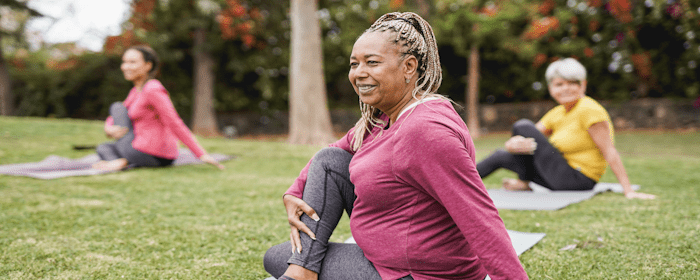
by admin | Jun 23, 2023 | Health Awareness, Alzheimer’s Disease
Caring for a loved one with Alzheimer’s disease can be emotionally challenging, especially when they experience agitation. Agitation is a common symptom of Alzheimer’s and can manifest as restlessness, pacing, aggression, or verbal outbursts. Witnessing your loved one in distress can be distressing for you as well. However, there are strategies and approaches you can employ to help manage and alleviate their agitation.
Here are some tips to assist you in supporting your loved one through this difficult time.
Identify triggers: Observe your loved one’s behavior and try to identify patterns or triggers that may lead to agitation. It could be certain activities, environments, or even specific times of the day. By recognizing these triggers, you can take steps to avoid or modify them, thereby reducing the likelihood of agitation.
Maintain a calm environment: Create a peaceful and soothing atmosphere for your loved one. Minimize noise, bright lights, and other sensory distractions that can contribute to agitation. Consider playing soft music or introducing familiar scents to promote relaxation.
Stick to a routine: Establishing a consistent daily routine can provide a sense of security and predictability for someone with Alzheimer’s. Help your loved one maintain regular sleep patterns, meals, and activities. Sudden changes or disruptions to their routine can increase agitation.
Practice effective communication: When interacting with your loved one, use simple and clear language. Speak slowly and calmly, maintaining eye contact. Avoid arguing or correcting them if they are confused or agitated. Instead, offer reassurance and validation of their feelings.
Engage in calming activities: Engaging your loved one in activities that they enjoy and find calming can help redirect their focus and reduce agitation. This could include listening to soothing music, doing puzzles, or going for a gentle walk together. Adjust the activities based on their abilities and interests.
Ensure physical comfort: Discomfort or pain can exacerbate agitation. Make sure your loved one is comfortable by addressing their physical needs. Check for hunger, thirst, or discomfort due to temperature. Regular exercise and massage can also promote relaxation and reduce restlessness.
Seek professional help: If agitation becomes persistent or unmanageable, it’s important to consult a healthcare professional. They can evaluate your loved one’s condition and suggest appropriate interventions or medications, if necessary. Additionally, support groups or counseling services can provide you with valuable guidance and emotional support throughout the caregiving journey.
Remember, caring for someone with Alzheimer’s requires patience and understanding. While you cannot eliminate agitation entirely, implementing these strategies can help alleviate your loved one’s distress and improve their quality of life. Don’t forget to prioritize self-care as well, as maintaining your own well-being is crucial in providing the best possible care for your loved one.

by admin | Jun 16, 2023 | Health Awareness, Multiple Sclerosis
Living an active lifestyle is important for individuals with multiple sclerosis (MS) as it can help manage symptoms, improve overall well-being, and maintain physical function.
Regular physical activity can help manage the symptoms associated with MS, such as fatigue, muscle weakness, spasticity, and balance issues. It has been shown to reduce fatigue and improve mood, leading to an overall enhanced sense of well-being. By engaging in regular exercise, individuals with MS can preserve and improve their physical function, including muscle strength, flexibility, and endurance.
What Are Some Activities?
Aerobic exercises, like walking or cycling, can improve cardiovascular fitness and reduce the risk of heart disease. Balance and coordination can be affected by MS, increasing the risk of falls. However, participating in activities that promote balance and coordination, such as yoga or tai chi, can enhance stability and reduce the risk of falls.
Regular physical activity also supports cognitive function, as it has been associated with improved memory, attention, and processing speed. Additionally, exercise can help manage weight, improve body composition, and promote a healthier overall body composition.
Include strength training exercises to improve muscle strength and tone. Work with a physical therapist or fitness professional to develop a safe and effective strength training program. Focus on major muscle groups, using resistance bands, free weights, or weight machines.
The social aspect of staying active is also beneficial, as it provides opportunities for social interaction, participation in group exercise classes, and joining support groups. This social connection can positively impact mental well-being and help individuals cope with the challenges of living with MS.
Be Sure to Stay Safe
Be adaptable as needed if certain exercises or movements are challenging due to MS symptoms. Adapt them to your abilities. For example, use assistive devices, modify the range of motion, or try seated exercises if necessary.
Start with realistic goals and gradually increase the intensity and duration of your activities. It is important that you listen to your body and know your limits. Pay attention to how your body feels during and after exercise. If you experience excessive fatigue, pain, or worsening of symptoms, adjust the intensity or take breaks as needed. It’s essential to strike a balance between staying active and allowing for proper rest and recovery.
Be sure to stay hydrated. Drink plenty of water before, during, and after exercise to stay hydrated, as MS can increase sensitivity to heat. Incorporate foods high in water content as an added benefit.
Ultimately, staying active can increase resilience, enhance the quality of life, and empower individuals to feel in control of their health and well-being. Consult with a healthcare professional before starting any exercise regimen, preferably one experienced in working with MS patients. They can provide personalized guidance based on your specific condition and abilities.

by admin | Jun 9, 2023 | Health Awareness
Adding salt or minerals to your water for hydration can have certain benefits. Here are a few potential advantages:
Electrolyte balance: Electrolytes are minerals that carry an electric charge and play a crucial role in maintaining proper fluid balance, nerve function, and muscle contractions. By adding a small amount of salt or minerals like potassium, magnesium, and calcium to your water, you can help replenish electrolytes lost through sweat or excessive urination. This can be particularly beneficial during intense physical activity or in hot weather conditions.
Enhanced hydration: Adding a pinch of salt to your water can improve its absorption and promote better hydration. The presence of electrolytes in water can aid in fluid retention and prevent dehydration by facilitating the absorption of water in the body.
Improved taste and palatability: Some people find plain water to be bland or unappealing, which can lead to inadequate fluid intake. Adding a touch of salt or minerals can enhance the taste of water, making it more enjoyable and encouraging you to drink more.
Replenishing trace minerals: Certain minerals, such as magnesium and potassium, are essential for various bodily functions. If your diet is lacking in these minerals, adding them to your water can be a convenient way to supplement your intake.
Support for active lifestyles: For individuals engaged in prolonged or vigorous exercise, consuming electrolytes through water with added salt or minerals can help prevent muscle cramps, fatigue, and maintain optimal performance.
It’s important to note that while adding salt or minerals to your water can have benefits, moderation is key. Excessive intake of salt or minerals can have negative health effects, such as increased blood pressure or electrolyte imbalances. It’s recommended to consult with a healthcare professional or a registered dietitian before making significant changes to your hydration routine or electrolyte supplementation.

by admin | Jun 2, 2023 | Health Awareness
If you’re struggling with health issues related to stress or other lifestyle difficulties, a support group might be able to help.
Support groups create an environment with other individuals who are experiencing similar, if not exact, circumstances. Support groups offer an opportunity to meet with other people who have similar problems, feelings, worries, or treatment side effects.
Here are some of the main benefits of participating in a support group.
You Feel Less Lonely
Diseases, injuries, and chronic pain can make you feel isolated, especially when no one around you has gone through what you’re going through.
Support groups can help alleviate feelings of loneliness by bringing you into a community with others who do know what you’re experiencing.
Reduced Symptoms of Anxiety and Depression
Feeling less lonely results in reduced symptoms of anxiety and depression. Support groups give you the opportunity to feel seen and understood, which can help minimize negative mental health symptoms like anxiety and depression.
Learn Different Coping Skills
Everyone has a different approach to managing difficulties in life. You will likely learn about new coping skills that can help you manage your problems.
Coping skills won’t make your challenges go away, but they help you self-manage your response in a healthier way.
Stay Motivated
Support groups can help you stay motivated to tackle the underlying causes of your chronic conditions. They can also encourage you to stick to your treatment plans, even if those plans are challenging.
Improve Your Understanding
Sharing in support groups can also help you better understand your condition and how it affects your life. Seeing things through the perspective of others adds dimension to how you view your condition.
Feel Empowered
Finally, support groups can help you feel empowered. They may offer a sense of hope or enhanced control over your life and conditions.
If you’ve felt lost or alone living with a chronic condition, try a support group near you.

by admin | May 26, 2023 | Health Awareness, Chronic Pain
Many health conditions and lifestyle factors lead to ongoing inflammation within the body. When you have widespread inflammation, it can lead to chronic pain, aches, and other health concerns.
If you want to lower inflammation and feel better overall, you may benefit from an anti-inflammatory diet. Learn more about the anti-inflammatory diet and what it includes below.
The Anti-Inflammatory Diet
While certain foods can trigger inflammation, others can reduce it. The anti-inflammatory diet limits inflammatory triggers and focuses primarily on foods that can lower inflammation.
Foods that Trigger Inflammation
Anti-inflammatory diets limit the following foods that are considered inflammation triggers:
- Red meat
- Processed foods
- Sugar
- Fried foods
- White bread
- Cookies, candy, and ice cream
- High sodium foods
- Alcohol
When these foods are highly restricted or altogether eliminated, it can lead to lower inflammation levels throughout the body.
Foods that Reduce Inflammation
While the anti-inflammatory diet restricts foods that are triggered, it calls for an increase in foods that can reduce inflammation. These foods include:
- Oily fish (tuna, salmon)
- Berries
- Green leafy vegetables
- Nuts and seeds
- Beans
- Olive oil
- Probiotics
- Tea
These anti-inflammatory foods are high in antioxidants and other properties that can decrease inflammation. When your diet consists mostly of these foods, you can see a significant reduction in widespread inflammation, which may lead to a resolution of chronic pain and other symptoms.
Starting an Anti-Inflammatory Diet
If you struggle with chronic inflammation and want to try the anti-inflammatory diet, always speak with your medical team beforehand. Making major dietary changes is very impactful and should be discussed with your doctor in advance.
It is important to make sure that the anti-inflammatory diet is a healthy fit for any underlying conditions you already have. It is also important to ensure you are healthy enough to make a major dietary change.

by admin | May 19, 2023 | Health Awareness, PRP
Corticosteroids are a popular treatment for a number of common conditions. Cortisone, prednisone, and hydrocortisone are the most popular corticosteroids used in the medical field. These steroids can be used to treat the following conditions and more:
These medications are available as tablets, injectables, inhalants, and topical creams, making them a viable solution for a multitude of health concerns. While corticosteroids can reduce inflammation and target certain sources of discomfort, they do not come without risks. Weigh the benefits and risks of corticosteroids here.
Benefits
Treatment with corticosteroids can provide a large array of medical benefits, depending on how they are used, and the condition being treated.
Corticosteroid tablets can be taken to reduce inflammation inside the body, while topical steroids can relieve itching and swelling of the skin. Injectable corticosteroids are an effective option for joint and muscle pain, while inhalant steroids ease the severity of asthma symptoms.
Along with the wide variety of uses for corticosteroids, another benefit is the speed with which they work. Corticosteroids take effect almost immediately, relieving your symptoms and helping you feel better in a matter of minutes.
Risks
While corticosteroids are effective, they do come with certain risks and precautions. The following are just a few of the side effects you may experience with corticosteroid use:
- High blood pressure
- High blood sugar
- Vision changes
- Swelling around the face (moon face)
- Skin lesions and bruising
- Fluid accumulation in the legs
- Slower wound healing
- Bone fractures
- Weight gain
- Mood swings
- Increased risk of infections
Before starting a treatment plan that involves corticosteroids, you should always review the risks and benefits with your medical team. Your doctors can help you determine whether steroids are the best course of action for your unique medical needs.
Regenerative Medicine vs. Corticosteroids
Regenerative medicine is a rapidly evolving field that aims to develop new therapies to treat a wide range of medical conditions, and many patients are exploring this option as an alternative option.
PRP (platelet-rich plasma) and corticosteroids are both commonly used in the treatment of various musculoskeletal conditions, but they work in different ways and are often used for different types of injuries.
PRP involves injecting a concentrated solution of a patient’s own blood platelets into the injured area. These platelets contain growth factors that can help to promote healing and tissue repair. PRP is commonly used for conditions such as tendonitis, ligament sprains, and muscle strains.
Corticosteroids, on the other hand, are a type of medication that is often used to reduce inflammation and pain in the body. They work by reducing the activity of the immune system and can be administered either orally, topically, or through injection. Corticosteroids are commonly used for conditions such as arthritis, bursitis, and other inflammatory conditions.
Both PRP and corticosteroids have their advantages and disadvantages. PRP can be more effective at promoting long-term healing and tissue repair, while corticosteroids can provide more immediate pain relief. However, corticosteroids can also have side effects such as weakening of the bones and tendons, while PRP is a relatively safe and natural treatment option.
The choice between PRP and corticosteroids ultimately depends on the specific injury or condition being treated, as well as the patient’s individual needs and preferences. Your healthcare provider can help you determine which treatment option is best for you.







 St. Petersburg, Florida
St. Petersburg, Florida
